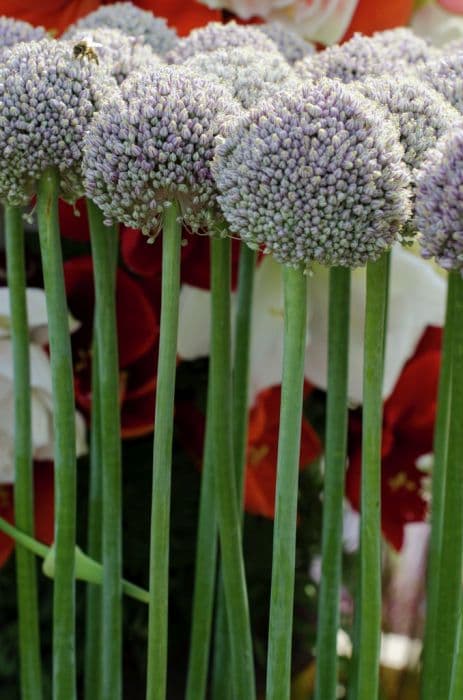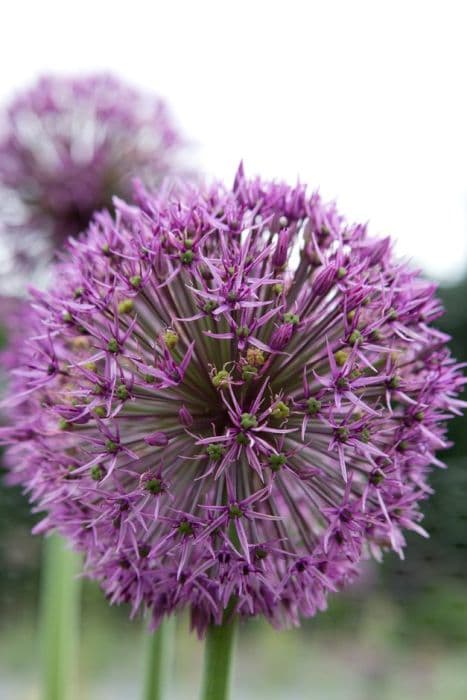Naples Garlic Allium neapolitanum Cowanii Group











ABOUT
Allium neapolitanum, commonly known as the White Naples Onion, presents itself with a distinctly ornamental character. The plant is most notable for its delicate clusters of star-shaped flowers, which are pure white and boast a striking effect when in full bloom. These flowers are arranged in an umbrella-like fashion at the top of a leafless stalk, creating a spherical or slightly elongated bouquet that hovers gracefully above the foliage. The foliage of the White Naples Onion consists of narrow, green leaves that emerge from the base of the plant. These leaves tend to be strap-like, creating a tuft of verdant green that sets the stage for the floral display above. As the bloom period progresses, the contrast between the bright white flowers and the greenery becomes increasingly dramatic. The individual flowers that make up the clusters are small, with six petals each spreading outwards, giving them a starry appearance. Within the center of each flower, one may notice the subtle reproductive structures, which are less prominent but complementary to the overall flower design. The White Naples Onion has a fresh, onion-like scent that becomes more noticeable when the leaves or stems are crushed, hinting at its culinary relatives. Despite its name suggesting otherwise, the plant is grown primarily for its aesthetic appeal rather than as a food source. In summary, the White Naples Onion captivates with its charming, white inflorescences, appealing to gardeners and flower enthusiasts alike for its simplistic beauty and the vibrant contrast it lends to gardens and landscapes.
About this plant
 Names
NamesFamily
Amaryllidaceae
Synonyms
Neapolitan Garlic, Naples Garlic, White Garlic, Daffodil Garlic, Wood Garlic, False Garlic
Common names
Allium neapolitanum Cirillo, Nectaroscordum neapolitanum (Cirillo) Galasso & Banfi, Allium album Griseb., Allium ambiguum Guss., Allium candidissimum Delile, Allium cowanii Lindl., Allium lacteum Brullo & Pavone, Allium subhirsutum L.
 Toxicity
ToxicityTo humans
The White Naples Onion is not considered highly toxic to humans. However, as with many Allium species, it may cause discomfort if ingested in large quantities. Symptoms could include digestive upset such as nausea, vomiting, and diarrhea. Individuals with a sensitivity to Alliums or those who consume a significant amount might experience more severe gastrointestinal distress. Generally, accidental ingestion of small amounts by humans is not expected to lead to serious toxicity.
To pets
The toxicity of the White Naples Onion to pets, especially cats and dogs, can be quite serious. Allium species contain compounds that can cause oxidative damage to red blood cells leading to hemolytic anemia. Symptoms of poisoning in pets can include vomiting, diarrhea, abdominal pain, lethargy, elevated heart and respiratory rates, weakness, and collapse. In severe cases, ingestion can result in jaundice, blood in the urine, or difficulty in breathing. Consuming even small amounts can be dangerous for pets, and immediate veterinary care is recommended if ingestion is suspected.
 Characteristics
CharacteristicsLife cycle
Perennials
Foliage type
Deciduous
Color of leaves
Green
Flower color
White
Height
1 foot (30 cm)
Spread
1 foot (30 cm)
Plant type
Bulb
Hardiness zones
7
Native area
Mediterranean
Benefits
 General Benefits
General Benefits- Ornamental Value: White Naples Garlic boasts attractive white flowers, enhancing garden aesthetics during its blooming season.
- Low Maintenance: It is known for being easy to care for, requiring minimal attention once established.
- Drought Tolerance: This plant is relatively resistant to periods of drought, making it suitable for xeriscaping or dry gardens.
- Pollinator Friendly: The flowers attract important pollinators like bees and butterflies, supporting local ecosystems.
- Natural Pest Repellant: The plant's scent is believed to deter certain pests, thus protecting surrounding plants.
- Edibility: Both the flowers and the bulb of White Naples Garlic are edible, offering a mild garlic flavor for culinary use.
- Seasonal Interest: With its spring blooms, it provides a seasonal highlight in the garden at a time when many plants are just awakening.
- Easy Propagation: It can be easily propagated through division, allowing gardeners to spread and share the plant with ease.
 Medical Properties
Medical PropertiesThis plant is not used for medical purposes.
 Air-purifying Qualities
Air-purifying QualitiesThis plant is not specifically known for air purifying qualities.
 Other Uses
Other Uses- Allium neapolitanum, commonly known as white garlic, can be used as a natural pest repellent in gardens, deterring pests like aphids with its strong scent.
- In floral arrangements, white garlic flowers provide a delicate and elegant touch, and their long-lasting blooms enhance the bouquet's longevity.
- White garlic can serve as a companion plant, when integrated into vegetable gardens, to help reduce the occurrence of certain fungal diseases.
- Due to its attractive flowers, white garlic is popular for ornamental use in public landscapes and park settings, contributing to the aesthetic value of green spaces.
- The plant can be used in educational gardens and schools to demonstrate the life cycle of bulbous plants and pollination processes.
- White garlic, being a low-maintenance plant, is suitable for xeriscaping, the practice of creating landscapes that reduce or eliminate the need for irrigation.
- The dried seed heads of white garlic can be used in crafts and decorative dried flower arrangements, providing an interesting texture and shape.
- White garlic can be included in wildlife-friendly gardens to attract bees, butterflies, and other beneficial insects that are drawn to its nectar-rich flowers.
- The plant's ability to naturalize in some environments makes it a good candidate for erosion control on mild slopes or areas where vegetation is desired to stabilize the soil.
- Lastly, Allium neapolitanum can be utilized in culinary demonstrations focusing on edible wild plants, despite this particular usage being uncommon compared to more traditional culinary alliums.
Interesting Facts
 Feng Shui
Feng ShuiThe White Naples Garlic is not used in Feng Shui practice.
 Zodiac Sign Compitability
Zodiac Sign CompitabilityThe White Naples Garlic is not used in astrology practice.
 Plant Symbolism
Plant Symbolism- Purity: The white flowers of the Neapolitanum onion often symbolize purity and innocence, reminiscent of its crisp, clean appearance.
- Unity: With its globe-shaped clusters of blossoms, the Neapolitanum onion represents unity and togetherness, reflecting how individual flowers come together to make a whole.
- Humility: Given its simplistic beauty and lack of grandeur, the Neapolitanum onion can symbolize humility and modesty.
- Prosperity and Abundance: As onions are a staple in many cultures, representing sustenance and growth, the Neapolitanum onion can be linked to prosperity and abundance.
- Patience and Perseverance: Growing from a bulb and enduring through colder seasons, the Neapolitanum onion is often associated with patience and the ability to persevere through challenges.
- Good Fortune: In some traditions, onions are thought to ward off evil spirits and bring good luck, translating to symbolic meanings of protection and good fortune for the Neapolitanum onion.
 Water
WaterThe Neapolitan Garlic should be watered thoroughly when the top inch of soil is dry to the touch. Generally, this might mean watering approximately every 7 to 10 days, depending on climatic conditions and the plant's environment. Ensure that water penetrates deep into the soil to reach the roots, but avoid overwatering as this can lead to bulb rot. An established plant might need about 1 gallon of water every week during the growing season, but always adjust your watering to the plant's needs and local weather conditions.
 Light
LightNeapolitan Garlic thrives in full sun to partial shade. The ideal spot for this plant is one where it can receive at least 6 hours of direct sunlight daily. However, in very hot climates, some afternoon shade can help protect the plant from excessive heat stress.
 Temperature
TemperatureNeapolitan Garlic prefers a temperate climate with temperatures ranging between 40 to 85 degrees Fahrenheit for optimal growth. It can tolerate cold down to around 20 degrees Fahrenheit, but for best performance, keep it away from environments where it will be exposed to extended periods of freezing temperatures. The ideal growing conditions typically include spring and autumn temperatures that remain within this range.
 Pruning
PruningPruning Neapolitan Garlic is generally done to remove spent flowers and encourage the plant to put energy into bulb development. After flowers fade, cut off the flower stalks but leave the foliage in place until it turns yellow and dies back naturally. This usually takes place in late summer or early fall. Pruning is not frequently needed outside of this post-blooming care.
 Cleaning
CleaningNot needed
 Soil
SoilWhite Flowering Onion thrives in well-draining soil with a mix of compost, and loam, ensuring good fertility and drainage. The best pH for this soil is slightly acidic to neutral, between 6.0 and 7.0.
 Repotting
RepottingWhite Flowering Onion typically does not need frequent repotting as it is usually grown as an annual or biennial. Only repot if the bulbs become overcrowded or to refresh the soil every few years.
 Humidity & Misting
Humidity & MistingWhite Flowering Onion prefers a moderate humidity level but is quite adaptable and tolerant to a range of humidity conditions typically found in outdoor gardening.
 Suitable locations
Suitable locationsIndoor
Place in bright light, well-draining soil, water when dry.
Outdoor
Plant in full sun, moderate soil moisture, well-drained spot.
Hardiness zone
7-10 USDA
 Life cycle
Life cycleAllium neapolitanum Cowanii Group, commonly known as White Flowering Onion, begins its life cycle with the germination of seeds in late summer or early autumn. After germination, it develops a small bulb from which the roots and foliage emerge, growing throughout the mild winter in Mediterranean or similar climates. In spring, the plant produces long, slender leaves and a tall stem topped with a spherical cluster of star-shaped white flowers. Following the flowering period, the plant sets seed, and as the seeds mature, the foliage begins to yellow and die back. The bulb enters a dormant phase during the hot summer months, conserving energy. Finally, the cycle starts anew when cooler temperatures and autumn rains signal the bulb to resume growth and prepare for the next generation of flowering.
 Propogation
PropogationPropogation time
Spring
Allium neapolitanum, commonly known as White Garlic, is most commonly propagated by dividing its bulbs. This is best done when the plants become dormant, generally in late summer to autumn. To propagate by division, carefully lift the clump of bulbs from the ground using a garden fork, then gently separate the individual bulbs from the cluster. Each bulb can then be replanted immediately, ideally about 3 inches (approximately 7.5 centimeters) deep and spaced 4 to 6 inches (about 10 to 15 centimeters) apart, in well-drained soil with good exposure to sunlight. Water the newly planted bulbs to help them establish, but ensure the soil is not waterlogged to prevent rot.









